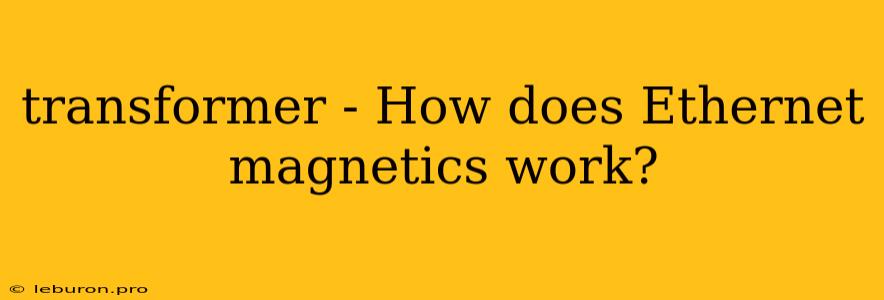How Does Ethernet Magnetics Work?
The world of data transmission relies heavily on the efficient and reliable transfer of information. While wireless technologies have made significant strides, wired connections remain the backbone of many networks, especially in high-performance scenarios. Ethernet, a ubiquitous standard for local area networks (LANs), relies on transformers to play a critical role in ensuring signal integrity and proper communication between devices. This article delves into the fascinating world of Ethernet magnetics, explaining the principles behind transformer operation and their crucial contribution to data transmission.
Understanding the Fundamentals: Why Transformers in Ethernet?
Ethernet, operating over twisted-pair cabling, relies on electrical signals to carry data. These signals, generated by devices like computers and network switches, travel through the copper wires. However, there are challenges in transmitting data over long distances:
- Signal Attenuation: As signals propagate, they weaken due to resistance in the cables, leading to signal degradation.
- Electromagnetic Interference (EMI): External sources of electromagnetic noise can corrupt the transmitted signals, leading to errors.
- Ground Loop Issues: Differences in ground potential between devices can create current loops, introducing noise and affecting data integrity.
Transformers, with their inherent properties of magnetic coupling and impedance transformation, effectively address these challenges. Let's examine how transformers work their magic in the context of Ethernet.
The Role of Transformers: A Closer Look
In Ethernet applications, transformers primarily serve two main functions:
1. Isolation and Impedance Matching
Transformers act as electrical isolators, preventing direct current paths between devices. This is crucial for preventing ground loops and ensuring that noise from one device doesn't affect another. The transformer winding configuration also allows for impedance matching. Impedance matching is critical for efficient power transfer, ensuring that the signal is transferred effectively from the transmitting device to the receiving device.
2. Common Mode Noise Rejection
Ethernet transformers are designed to suppress common mode noise. Common mode noise occurs when unwanted signals travel along both conductors of the twisted pair cable. This noise is particularly problematic as it can easily interfere with the data signal. Transformers have a unique ability to block common mode signals while allowing the desired differential signal to pass through.
The Transformer's Internal Structure
Ethernet transformers typically consist of two or more windings, each wound around a ferromagnetic core. The core material, often ferrite or powdered iron, is chosen for its magnetic properties, which facilitate the creation of a magnetic field.
The primary winding receives the signal from the transmitting device. This signal induces a magnetic field in the core, which in turn induces a current in the secondary winding. The secondary winding delivers the signal to the receiving device. The number of turns in the primary and secondary windings determines the impedance ratio of the transformer, which is crucial for impedance matching between the transmitting and receiving devices.
Types of Ethernet Transformers
Several types of transformers are used in Ethernet applications, each tailored to specific requirements:
1. Pulse Transformers
These transformers are designed for high-speed data transmission, commonly used in 10BASE-T, 100BASE-TX, and Gigabit Ethernet (1000BASE-T) applications. They prioritize fast rise and fall times, minimizing signal distortion.
2. Data Transformers
Data transformers handle data signals with a wider range of frequencies, including those found in 10GBase-T and higher-speed Ethernet standards. They offer improved noise suppression and frequency response characteristics.
3. Magnetics for PoE (Power over Ethernet)
Power over Ethernet (PoE) relies on transformers with specialized designs to handle both data and power signals simultaneously over the same twisted pair cable. PoE transformers are typically larger than data transformers to handle higher power levels.
Choosing the Right Transformer
Selecting the appropriate transformer is critical for ensuring optimal data transmission performance. Factors to consider include:
- Ethernet Standard: The transformer must be compatible with the specific Ethernet standard (e.g., 10BASE-T, 100BASE-TX, Gigabit Ethernet).
- Data Rate: Higher data rates require transformers with wider bandwidth capabilities.
- Operating Environment: The transformer should be chosen based on the environmental conditions it will operate in, including temperature, humidity, and potential electromagnetic interference.
Conclusion: Transformers - The Unsung Heroes of Ethernet
Transformers play a crucial role in Ethernet networks, ensuring reliable data transmission by isolating signals, suppressing noise, and matching impedances. By understanding how these transformers work and the factors involved in selecting the right ones, engineers can design and build robust Ethernet systems that meet the ever-increasing demands for high-speed, reliable data communication. The seemingly simple, often overlooked transformer truly deserves its place as an essential component in the vast world of Ethernet connectivity.
